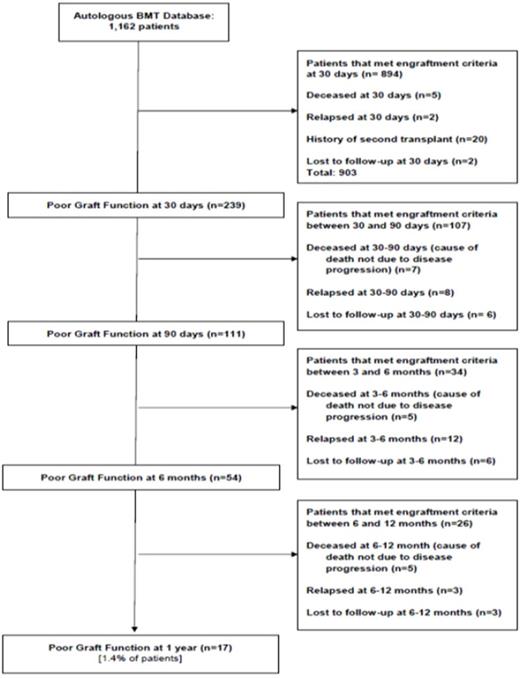Abstract
Introduction: A limited knowledge exists regarding the incidence and risk factors of poor graft function (PGF) following ASCT. There are multiple factors related to either quality of infused hematopoietic cells such as inadequate numbers or poor viability, or host factors such as chemotherapy induced stromal damage, bone marrow fibrosis, post-transplant infections, relapse, or drug-induced myelosupression which can contribute to development PGF in ASCT recipients.
Methods: Quality of engraftment of 1,162 patients (pts) who received ASCT at a single institution from 01/1996 to 08/2016 were retrospectively reviewed. PGF was defined as: platelet count ≤50,000/μL, Hgb ≤8 g/dL, absolute neutrophil count ≤1,000/mm3 or requirement of transfusions of blood products starting at 30 days post ASCT. Pts who received more than one ASCT, and those lost to follow-up within one-year of ASCT were excluded from analysis.
Results: Out of 1162 pts, there were 666 males (57.3%) and 496 females (42.7%) with a median age of 58 years (14-81 years). The median follow-up time was 21.5 months (1-116 months). Multiple myeloma was diagnosed in a majority of patients (682, 58.7%).146 pts (12.6%) had diffuse large B-cell lymphoma, 70 pts (6%) had mantle cell lymphoma, and 138 pts (11.9%) had Hodgkin's Lymphoma. Relapse was found in 23/239 (9.6%) of pts at a median time to relapse at 117 days. 17/239 (7%) patients died of other causes. 239 pts (21%) without relapse were found having PGF at Day 30 after ASCT (Fig 1). Out of these 239 pts, 194 (81.2%) had inadequate platelet recovery, 42 (17.6%) had inadequate recovery of both Hgb and platelets, and 3 (1.2%) had inadequate recovery of hemoglobin alone. There were no pts with inadequate neutrophil recovery at day 30. Of the 239 pts who had PGF at 30 days, 111 (46.4%) continued having PGF at day 90 after ASCT, with poor platelet engraftment in 100/111 (90%) pts, and poor Hgb and platelet recovery in 11/100 (10%) pts. At 6 months after ASCT, 54 patients (5%) were still showing PGF with inadequate platelet recovery in 49/54 (91%) pts and poor Hgb and platelet recovery in 5/54 (9%) pts. At 12 months post ASCT, 17 pts (1.4%) had PGF with inadequate platelet engraftment in all 17 pts. Pts with PGF received median stem cell dose (SCD) of 4.5X106 CD34/kg (range 1.4-10.5X 106 CD34/kg). Only 5/239 pts with PFG received SCD < 2X106 CD34/kg and only 2/5 pts had a PGF lasting > 6 months. No pts received cell products with cell viability <85%. Clinical and laboratory characteristics of patients with PGF lasting 30 days, 90 days, 6 months, and one year were compared by age, sex, race, weight, CMV status, conditioning regimen, and pre-transplant white count, hemoglobin/hematocrit, and platelet count. Among all groups, factors found not to influence PGF included age (53.5-54.3 years), conditioning regimen, transfusion dependence (21.8%-27.0%), pre-transplant white blood cell count (4.2-6.2/mm3), pre-transplant platelet count (116-138/mm3), or race. Predisposing factors for prolonged PGF included past CMV infection (p<0.01), pre-transplant weight (p<0.01), pre-transplant hemoglobin (p<0.05), and pre-transplant hematocrit (p<0.05).
Conclusion: PGF remains a common complication after ASCT in pts without relapsed disease even if adequate dose and viability of stem cells are infused. Inadequate platelet recovery is the most frequent manifestation of PGF which can persists longer than 6 months. CMV status, weight, and pre-transplant hemoglobin/hematocrit were predisposing factors for development of prolonged PGF lasting more than 3 months.
Cogle: Celgene: Other: Membership on Steering Committee for Connect MDS/AML Registry. Norkin: Celgene: Honoraria, Research Funding.
Author notes
Asterisk with author names denotes non-ASH members.


This feature is available to Subscribers Only
Sign In or Create an Account Close Modal